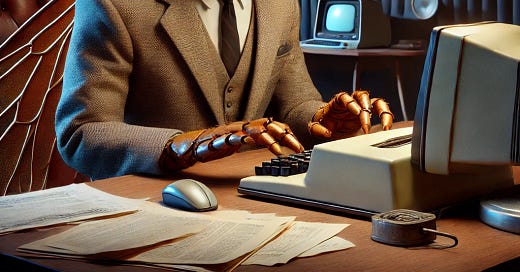The Bugman toiled in stupor
Until that fateful day
When first arose the clamor
Fenestrae Delendae
From the Eyes there was no quarter
The Ears did listen too
The World lay in the glooming
Of Iridescent blue.
In an incessant streaming
From strange lands the Mirrors came
Who stared into their countenance
Never again was quite the same
Until one day one dared to cleave
His Mirror into two
He saw the hidden workings
And broke the cursed rule
For then was the spell broken
No longer was he a fool
From then on it could no longer
be said that Mirrors rule.
You are very lucky indeed. You live at a time between two civilizations; the unraveling of the modern world provides a wondrous opportunity for those who wish to build. Before doing so, it is necessary to gain a clear view of the world in which one lives. As it is universally apparent that our lives have been shaped by technology, it is therefore logical to reflect on the true nature of technology itself. Technology is the application of the laws of nature to the ends of man. Many problems have but one solution, but most problems have nearly an infinite number. If technology is regarded as a solution to a problem, it follows that a given problem may have many equally valid technological solutions. Most of us would acknowledge that a transistor is better than a vacuum tube. If that is so, in which way is that true? Transistors are small and compact, and can be made readily and cheaply. However, it is perfectly logical to argue that vacuum tubes are superior, based on other characteristics. They last longer, and can be made entirely from materials found within the United States.
Therefore, we must consider the purpose that each technological invention serves. It is clear that machines serve only those who understand their functioning. For this reason, the best machine is that which can be modified by its user for his own ends. In short, it is necessary that man be master of machine.
Most desktop computers exhibit this quality at least to some degree. They possess terminals in which all software and system property are laid bare to the user, and almost infinitely mutable. The same cannot be said of what are commonly referred to as “smart” cell phones and tablets. In such devices, the method of control is hidden. For instance, on an Android device, one must press a button exactly seven times to access the Developer Mode. All software is hidden in an “App Store” or similar monopolistic arrangement. Such machines are typically devoid of USB ports, requiring the transmission of files through the dubious medium of the “cloud”. Therefore such devices seemingly construct a scenario where machine is master of man. Since no machine is truly intelligent, this is clearly an illusion. Therefore, this scenario is rather an insidious form of social control.
For this reason can such devices as smartphone and tablets be regarded as Skinner boxes designed not for mice, but for men. Since the content disseminated through them tends to activate the reward center of the brain, instead of the higher faculties of reason, they have been increasingly termed “dopamine traps”. They are designed largely to view content stored remotely, that is controlled by the developer instead of the user. As noted elsewhere on Tom Swift, this renders the content infinitely mutable, enabling the developers of such applications to shape the users perception of reality.
For this reason imperative that free citizens cast these machines out of their lives. While some might regard such an endeavor as a lost cause of Luddites, it is instead best viewed as a challenge for inventors. In a world independent from a universal device, there are far more opportunities to develop machines than would otherwise exist. The best path towards such a world is through founding associations which reject the products of the technological conglomerates. The first steps towards this end will not be trivial, as they will require the deliberate abandonment of convenience as a virtue. However, this has become far more feasible than in past years, with the development of intuitive distributions of Linux. A first step would be to create an easy to use Linux machine for small businesses, as well as a cell phone based on this operating system. Therefore, the next article in this series will be a brief overview of the best open source alternatives to commonly used subscription software. Therefore, the development of alternative technological infrastructure is critical for the foundation of computational independence.




